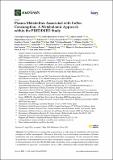Por favor, use este identificador para citar o enlazar a este item:
http://hdl.handle.net/10261/214434COMPARTIR / EXPORTAR:
 SHARE SHARE
 CORE
BASE CORE
BASE
|
|
| Visualizar otros formatos: MARC | Dublin Core | RDF | ORE | MODS | METS | DIDL | DATACITE | |

| Título: | Plasma Metabolites Associated with Coffee Consumption: A Metabolomic Approach within the PREDIMED Study |
Autor: | Papandreou, Christopher; Hernández-Alonso, Pablo; Bulló, Mònica; Ruiz‐Canela, Miguel; Yu, Edward; Guasch‐Ferré, Marta; Toledo, Estefania; Dennis, Courtney; Deik, Amy; Clish, Clary B.; Razquin, Cristina; Corella, Dolores; Estruch, Ramón; Ros, Emilio; Fitó, Montserrat; Arós, Fernando; Fiol, Miquel; Lapetra, José; Ruano, Cristina; Liang, Liming; Martínez-González, Miguel Ángel; Hu, Frank B.; Salas-Salvadó, Jordi | Palabras clave: | Coffees Caffeine Plasma Metabolomics PREDIMED |
Fecha de publicación: | 8-may-2019 | Editor: | Multidisciplinary Digital Publishing Institute | Citación: | Nutrients 11(5): 1032 (2019) | Resumen: | Few studies have examined the association of a wide range of metabolites with total and subtypes of coffee consumption. The aim of this study was to investigate associations of plasma metabolites with total, caffeinated, and decaffeinated coffee consumption. We also assessed the ability of metabolites to discriminate between coffee consumption categories. This is a cross-sectional analysis of 1664 participants from the PREDIMED study. Metabolites were semiquantitatively profiled using a multiplatform approach. Consumption of total coffee, caffeinated coffee and decaffeinated coffee was assessed by using a validated food frequency questionnaire. We assessed associations between 387 metabolite levels with total, caffeinated, or decaffeinated coffee consumption (≥50 mL coffee/day) using elastic net regression analysis. Ten-fold cross-validation analyses were used to estimate the discriminative accuracy of metabolites for total and subtypes of coffee. We identified different sets of metabolites associated with total coffee, caffeinated and decaffeinated coffee consumption. These metabolites consisted of lipid species (e.g., sphingomyelin, phosphatidylethanolamine, and phosphatidylcholine) or were derived from glycolysis (alpha-glycerophosphate) and polyphenol metabolism (hippurate). Other metabolites included caffeine, 5-acetylamino-6-amino-3-methyluracil, cotinine, kynurenic acid, glycocholate, lactate, and allantoin. The area under the curve (AUC) was 0.60 (95% CI 0.56–0.64), 0.78 (95% CI 0.75–0.81) and 0.52 (95% CI 0.49–0.55), in the multimetabolite model, for total, caffeinated, and decaffeinated coffee consumption, respectively. Our comprehensive metabolic analysis did not result in a new, reliable potential set of metabolites for coffee consumption. | Versión del editor: | http://dx.doi.org/10.3390/nu11051032 | URI: | http://hdl.handle.net/10261/214434 | DOI: | 10.3390/nu11051032 | Identificadores: | doi: 10.3390/nu11051032 issn: 2072-6643 |
| Aparece en las colecciones: | (IBIS) Artículos |
Ficheros en este ítem:
| Fichero | Descripción | Tamaño | Formato | |
|---|---|---|---|---|
| nutrients-11-01032.pdf | 582,65 kB | Adobe PDF |  Visualizar/Abrir |
CORE Recommender
PubMed Central
Citations
10
checked on 13-abr-2024
SCOPUSTM
Citations
17
checked on 23-abr-2024
WEB OF SCIENCETM
Citations
14
checked on 22-feb-2024
Page view(s)
164
checked on 23-abr-2024
Download(s)
74
checked on 23-abr-2024

